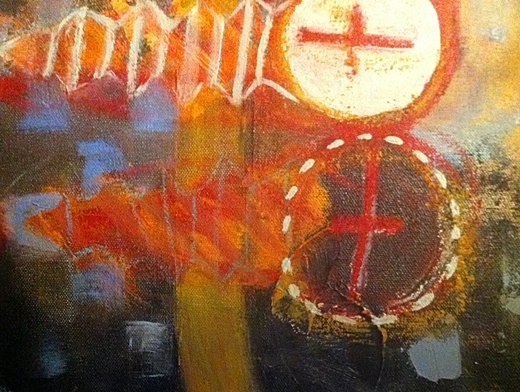 Image above: Detail of "The Heirloom" cover art by Charlott Martin. From original article.
Image above: Detail of "The Heirloom" cover art by Charlott Martin. From original article.
The Heirloom is a riveting, fast-paced story about some of the characters caught up in a rapidly collapsing United States. This tale meets the plausibility test requisite of a any good novel. On that front, I find it far superior to James Howard Kunstler’s post-peak superstition-laced novels, World Made by Hand and Witches of Hebron. The Heirloom is available for $4.99 for Kindle through Amazon.com (http://www.amazon.com/The-Heirloom-ebook/dp/B004JKMV8G).
Author Richard Davies is adjunct professor of English at Wichita State University. This debut novel is intended to be the first of a trilogy.
The central characters are Jerome Naiche, an internationally renowned physicist from UC-Berkeley and Harris Red Moon, his much-younger, self-absorbed assistant (i.e., driver). Naiche sees the light about “free energy” toward which he has spent his career work working just as the nation is unraveling. He co-opts techno-optimist Red Moon into driving the two of them to the eponymous heirloom farm in North Dakota, where Naiche’s daughter Kathy founded a back-to-the-land movement 16 years earlier (Kathy’s son Ben is the product of a one-night stand with Harris when she visited her professorial father in Berkeley). The rapid escape from Berkeley for the interior U.S. leaves behind Red Moon’s on-again, off-again girlfriend Emma, an activist for Earth Liberation Front.
At the most superficial level, The Heirloom is a battle between the newly enlightened professor and his long-time, techno-optimist driver. But this personal battle is a foil and metaphor for the larger struggle being waged between the U.S. Department of Homeland Security and a nascent anti-civ movement. Davies imbues his characters with sufficient complexity to destroy potentially abundant stereotypes: There are no white hats to inform the reader which of the characters are good guys, and no black hats to indicate the bad guys. These are real people with significant differences of opinion based on emotions rooted in personal histories.
The story is focused on characters and the rapidly changing world they inhabit. Davies subtly weaves in several important concepts while challenging mainstream views. The long-sought miracle of free energy, in the form of fusion, is a central theme. But Davies acknowledges early in the book that free energy doesn’t eliminate limits to growth (p. 23): “Even if fusion could be put in place with a finger-snap, the result would not be freedom but an immense population increase—until population growth stopped when the least link in the chain broke. No amount of energy in the world could make new, green, unpolluted, biodiverse land, or fertile oceans, or fresh water unless you counted desalination which would lead to immense piles of salt that had to go somewhere, which would lead to toxic salt dumps, which would lead to changes in the ocean’s chemical balance, which would lead to a plankton die-off, which would lead to the loss of half the world’s oxygen production, and which would lead to the death of the human species.” Most of the characters in The Heirloom, reflecting most people who have not thought about the issue as deeply as Davies, never awaken to the simple fact that there are limits to growth. Harris Red Moon is the archetype of this shallow level of thought.
Davies understands academia (and also recognizes academia as a mirror of American culture), and he provides a subtle overview (p. 25):
“Intercut with stock images from past senate visits were the absolute realities of life as an academic: the petty budget concerns, protecting one’s fief, the need to never appear ridiculous or out of step, the careful cultivation of one’s facade. Except for the freakish outlier, the star performer, or rainmaker, the academic species was surprisingly herd-like. Change was not in its vocabulary.”
Climate chaos makes an occasional appearance, as when the prominent physicist’s daughter, who runs the heirloom seed farm to which Naiche and Red Moon make their initial escape, pragmatically considers how to produce food in light of environmental collapse (p. 89): “Unfortunately, she had to presume that industrial man would continue to produce toxins and thus continue to induce climate change. This would cause the collapse of the ecosystem, and the real question would become, which way did the tipping tip? Would the world see a collapse of the thermohaline cycle in the ocean and thus a new ice age? Or would warming continue, forcing life to fall back into the Arctic and Antarctic regions? She sighed. How could she prepare for all these things? The undoing was as dangerous as the doing.”
The Heirloom covers a lot of intellectual ground without leaving a small geographic area. In addition to serving as a penetrating look at our present and our potential future, it serves as a coming-of-age story for Ben Naiche, grandson of the reborn physicist and son of Kathy (the physicist’s farmer daughter) and Harris Red Moon (the physicist’s long-time assistant). Young Ben is torn between the rapidly vanishing techno-world and the rapidly vanishing remnants of his native heritage. Like me, and most thoughtful people, he is torn between his own narcissistic desires and the longing for a more durable future for humanity and the living planet.
Ultimately, The Heirloom is a wide-ranging tale about the human experience. It is about life, love, death, honor, and people struggling to make their way in a world not of their choosing. The characters are developed sufficiently to become familiar. I cheered and booed along the way, sometimes at the same character.
For me, a novel is worthy if it satisfies two criteria: It tells me something about the world and something about the human condition. This book easily passes these tests, and it’s enjoyable, too. I recommend it very highly.
.
1 comment :
Juan recommended The Heirloom to me and I'm very glad he did. This is an exceptional story and I recommend it strongly.
Allen
Post a Comment